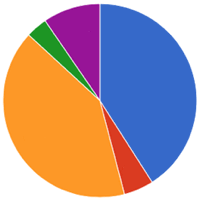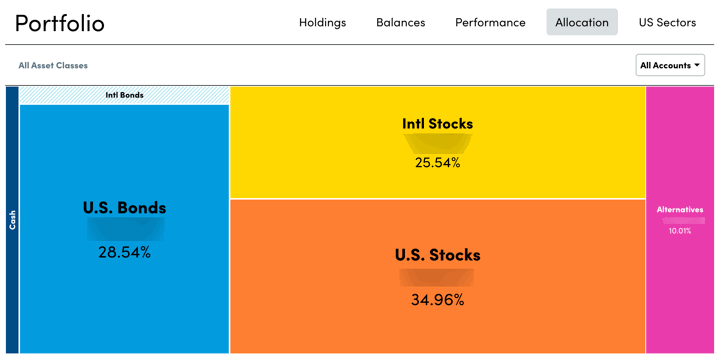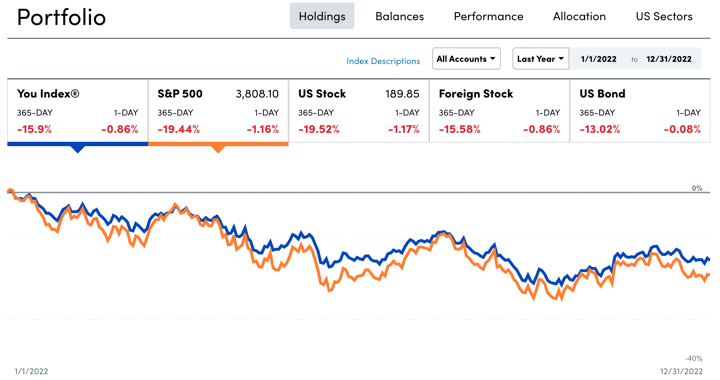 Here’s my quarterly update on my current investment holdings as of the end of 2022, including our 401k/403b/IRAs and taxable brokerage accounts but excluding real estate and side portfolio of self-directed investments. Following the concept of skin in the game, the following is not a recommendation, but just to share our real, imperfect, low-cost, diversified DIY portfolio. Wouldn’t it be nice if everyone else did the same? (Many people do track the 13F filings of well-known investors.)
Here’s my quarterly update on my current investment holdings as of the end of 2022, including our 401k/403b/IRAs and taxable brokerage accounts but excluding real estate and side portfolio of self-directed investments. Following the concept of skin in the game, the following is not a recommendation, but just to share our real, imperfect, low-cost, diversified DIY portfolio. Wouldn’t it be nice if everyone else did the same? (Many people do track the 13F filings of well-known investors.)
“Never ask anyone for their opinion, forecast, or recommendation. Just ask them what they have in their portfolio.” – Nassim Taleb
How I Track My Portfolio
Here’s how I track my portfolio across multiple brokers and account types. There are limited free options nowadays as Morningstar recently discontinued free access to their portfolio tracker. I use both Personal Capital and a custom Google Spreadsheet to track my investment holdings:
- The Personal Capital financial tools and real-time tracking (free, possible $100 bonus) automatically logs into my different accounts, adds up my various balances, tracks my performance, and calculates my overall asset allocation daily.
- Once a quarter, I also update my manual Google Spreadsheet (free to copy, instructions) because it helps me calculate how much I need in each asset class to rebalance back towards my target asset allocation. I also create a new tab each quarter, so I have an archive of my holdings dating back many years.
End of 2022 Asset Allocation and YTD Performance
Here are updated performance and asset allocation charts, per the “Allocation” and “Holdings” tabs of my Personal Capital account.


Target Asset Allocation. I call this my “Humble Portfolio” because it accepts the repeated findings that individuals cannot reliably time the market, and that persistence in above-average stock-picking and/or sector-picking is exceedingly rare. Costs matter and nearly everyone who sells outperformance, for some reason keeps charging even if they provide zero outperformance! By paying minimal costs including management fees and tax drag, you can essentially guarantee yourself above-average net performance over time.
I own broad, low-cost exposure to productive assets that will provide long-term returns above inflation, distribute income via dividends and interest, and finally offer some historical tendencies to balance each other out. I have faith in the long-term benefit of owning businesses worldwide, as well as the stability of high-quality US Treasury debt. My stock holdings roughly follow the total world market cap breakdown at roughly 60% US and 40% ex-US. I add just a little “spice” to the vanilla funds with the inclusion of “small value” ETFs for US, Developed International, and Emerging Markets stocks as well as additional real estate exposure through US REITs.
I strongly believe in the importance of knowing WHY you own something. Every asset class will eventually have a low period, and you must have strong faith during these periods to truly make your money. You have to keep owning and buying more stocks through the stock market crashes. You have to maintain and even buy more rental properties during a housing crunch, etc. A good sign is that if prices drop, you’ll want to buy more of that asset instead of less. I don’t have strong faith in the long-term results of commodities, gold, or bitcoin – so I don’t own them.
I do not spend a lot of time backtesting various model portfolios, as I don’t think picking through the details of the recent past will necessarily create superior future returns. You’ll find that whatever model portfolio is popular in the moment just happens to hold the asset class that has been the hottest recently as well.
Find productive assets that you believe in and understand, and just keep buying them through the ups and downs. Mine may be different than yours.
I have settled into a long-term target ratio of roughly 70% stocks and 30% bonds (or 2:1 ratio) within our investment strategy of buy, hold, and occasionally rebalance. My goal is more “perpetual income portfolio” as opposed to the more common “build up a big stash and hope it lasts until I die” portfolio. My target withdrawal rate is 3% or less. Here is a round-number breakdown of my target asset allocation.
- 30% US Total Market
- 5% US Small-Cap Value
- 20% International Total Market
- 5% International Small-Cap Value
- 10% US Real Estate (REIT)
- 15% US Treasury Nominal Bonds or FDIC-insured deposits
- 15% US Treasury Inflation-Protected Bonds (or I Savings Bonds)
Commentary. The goal of this “Humble Portfolio” is to create sustainable income that keeps up with inflation to cover our household expenses. According to Personal Capital, my portfolio went down about 16% for 2022. There was only a little minor rebalancing to be done this quarter.
Due to the rising real yield on TIPS, I have shifted back to a target bond allocation of roughly 50% US Treasury/Bank CDs and 50% TIPS/I Savings Bonds. My traditional Treasuries are of intermediate term, and I may convert to a manual ladder of them in the future. My TIPS are also of intermediate to long-term, depending on the real yields available at the time of purchase. I have been manually buying individual TIPS of longer terms this quarter. 1.6% real yield may not be terribly exciting, but it’s a lot better that was available for a long time, and it may be better that what will be available in the future.
I’ll share about more about the income aspect in a separate post.
 The Best Credit Card Bonus Offers – October 2024
The Best Credit Card Bonus Offers – October 2024 Big List of Free Stocks from Brokerage Apps
Big List of Free Stocks from Brokerage Apps Best Interest Rates on Cash - October 2024
Best Interest Rates on Cash - October 2024 Free Credit Scores x 3 + Free Credit Monitoring
Free Credit Scores x 3 + Free Credit Monitoring Best No Fee 0% APR Balance Transfer Offers
Best No Fee 0% APR Balance Transfer Offers Little-Known Cellular Data Plans That Can Save Big Money
Little-Known Cellular Data Plans That Can Save Big Money How To Haggle Your Cable or Direct TV Bill
How To Haggle Your Cable or Direct TV Bill Big List of Free Consumer Data Reports (Credit, Rent, Work)
Big List of Free Consumer Data Reports (Credit, Rent, Work)
I’m curious why you buy REITs separately. Aren’t they part of the broad index funds already?
My preference would be to have a 10% allocation in XLE just because I like energy companies but I make myself just do a target date fund because no one knows what’s going to happen.
They are part of the broad index funds (about 3% to 4% of US if I recall), which would make it only about 1% or 2% of my total portfolio. There is ongoing debate as to whether they should be held separately. I don’t feel terribly strongly either way. Here are some previous thoughts on the matter:
https://www.mymoneyblog.com/the-case-against-reits-as-a-separate-asset-class-holding.html
I do like the idea of holding real estate, but I don’t want to own single family rentals based on personal experience. REITs are also required to distribute 90% of their income as dividends, which to me is another indicator that they are different from other stocks. I’m okay just collecting this required rent check from REITs rather than dealing with being a landlord myself, even with a property management company.
Thanks for sharing Jonathan. IMHO, International is no longer a diversifier against US equities so I’ve brought that down to 0% of my portfolio. I’ll get foreign exposure from US based companies operating abroad. I’m also reallocating my fixed income exposure from bond funds to 4 year CDs which are right now paying 4%. I wont worry to worry about interest rate risk for 4 years. Alternatives other than being a non correlated diversifier, havent offerred much return in my experience. So I would allocate that to CDs as well. Happy investing.
Wouldn’t it be easier to take your dividends from your holdings at your brokerage firm (s) and just divide the total assets you hold to determine your yearly yield? Fidelity, Schwab, Vanguard and ML all provide this info.